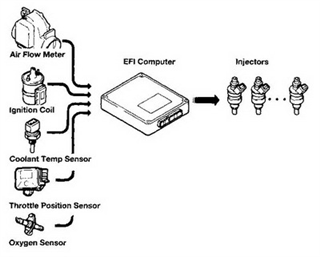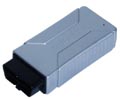- Engine Sensors
- |
- Fuel Injection
- |
- Repair Basics
- |
- Technical Info
- |
- Car Tech Info
- |
- MicroTronik
Engine Sensors
In order to provide the correct amount of fuel for every operating condition, the engine control unit (ECU) has to monitor a huge number of input sensors. Here are just a few:· Mass airflow sensor - Tells the ECU the mass of air entering the engine
· Oxygen sensor(s) - Monitors the amount of oxygen in the exhaust so the ECU can determine how rich or lean the fuel mixture is and make adjustments accordingly
Every new car, and most cars produced after 1980, has an oxygen sensor. The sensor is part of the emissions control system and feeds data to the engine management computer. The goal of the sensor is to help the engine run as efficiently as possible and also to produce as few emissions as possible.
A gasoline engine burns gasoline in the presence of oxygen. It turns out that there is a particular ratio of air and gasoline that is (perfect), and that ratio is 14.7:1 (different fuels have different perfect ratios the ratio depends on the amount of hydrogen and carbon found in a given amount of fuel). If there is less air than this perfect ratio, then there will be fuel left over after combustion. This is called a rich mixture. Rich mixtures are bad because the unburned fuel creates pollution. If there is more air than this perfect ratio, then there is excess oxygen. This is called a lean mixture. A lean mixture tends to produce more nitrogen-oxide pollutants, and, in some cases, it can cause poor performance and even engine damage.
The oxygen sensor is positioned in the exhaust pipe and can detect rich and lean mixtures. The mechanism in most sensors involves a chemical reaction that generates a voltage (see the patents below for details). The computer of the engine looks at the voltage to determine if the mixture is rich or lean, and adjusts the amount of fuel entering the engine accordingly.
The reason why the engine needs the oxygen sensor is because the amount of oxygen that the engine can pull in depends on all sorts of things, such as the altitude, the temperature of the air, the temperature of the engine, the barometric pressure, the load on the engine, etc.
When the oxygen sensor fails, the computer can no longer sense the air/fuel ratio, so it ends up guessing. Your car performs poorly and uses more fuel than it needs to.
· Throttle position sensor: Monitors the throttle valve position (which determines how much air goes into the engine) so the ECU can respond quickly to changes, increasing or decreasing the fuel rate as necessary
· Coolant temperature sensor: Allows the ECU to determine when the engine has reached its proper operating temperature
· Voltage sensor: Monitors the system voltage in the car so the ECU can raise the idle speed if voltage is dropping (which would indicate a high electrical load)
· Manifold absolute pressure sensor: Monitors the pressure of the air in the intake manifold
The amount of air being drawn into the engine is a good indication of how much power it is producing; and the more air that goes into the engine, the lower the manifold pressure, so this reading is used to gauge how much power is being produced.
· Engine speed sensor: Monitors engine speed, which is one of the factors used to calculate the pulse width
There are two main types of control for multi-port systems:
· The fuel injectors can all open at the same time.
· Or each one can open just before the intake valve for its cylinder opens (this is called sequential multi-port fuel injection).
The advantage of sequential fuel injection is that if the driver makes a sudden change, the system can respond more quickly because from the time the change is made, it only has to wait only until the next intake valve opens, instead of for the next complete revolution of the engine.
The engine control unit uses a formula and a large number of lookup tables to determine the pulse width for given operating conditions. The equation will be a series of many factors multiplied by each other. Many of these factors will come from lookup tables. We will go through a simplified calculation of the fuel injector pulse width. In this example, our equation will only have three factors, whereas a real control system might have a hundred or more.
Performance Chips
This leads us to our discussion of performance chips. Now that we understand a little bit about how the control algorithms in the ECU work, we can understand what performance-chip makers do to get more power out of the engine.
Performance chips are made by aftermarket companies, and are used to boost engine power. There is a chip in the ECU that holds all of the lookup tables; the performance chip replaces this chip. The tables in the performance chip will contain values that result in higher fuel rates during certain driving conditions. For instance, they may supply more fuel at full throttle at every engine speed. They may also change the spark timing (there are lookup tables for that, too). Since the performance-chip makers are not as concerned with issues like reliability, mileage and emissions controls as the carmakers are, they use more aggressive settings in the fuel maps of their performance chips.
AutoHex (Auto Diagnostic scanner) is one of the best Professional scan tools to for Cars; Autohex Scanner can test the Systems of the Car effectively and easily, with many powerful features to help you in diagnosing and testing.
- Coolant Temperature Sensor
The following section give some details about Coolant Temperature Sensor input to the ECM of the vehicle that contribute towards the desired injector duration
- Air Flow Meters
The following section give some details about Air Flow Meter Sensors input to the ECM of the vehicle that contribute towards the desired injector duration
- EGR Valve Position (EVP) Sensor
The following section give some details about EGR Valve Position (EVP) Sensor input to the ECM of the vehicle that contribute towards the desired injector duration.
- The Hall-Effect Sensor
The following section give some details about The Hall-Effect Sensor input to the ECM of the vehicle that contribute towards the desired injector duration.
- Vehicle Speed Sensor
The following section give some details about Vehicle Speed Sensor input to the ECM of the vehicle that contribute towards the desired injector duration.
Programming BMW F Series



